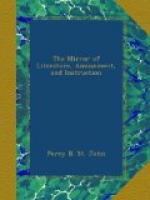From the time of the departure of George the Fourth from Edinburgh, in 1822, Holyrood Palace remained without any distinguished inhabitant until last year, when Charles the Tenth, and his suite, took up their abode within its walls. In the same year too, died George IV.
[1] A view of the Chapel,
from the Diorama, in the Regent’s Park,
with
ample descriptive details, will be found in vol. v.
of
The
Mirror.
* * * * *
THE LAST SOUNDS OF BATTLE.
(For the Mirror.)
Hark! on yonder blood-trod hill,
The sound of battle lingers still,—
But faint it comes, for every blow
Is feebled with the touch of woe:
Their limbs are weary, and forget
They stand upon the battle plain,—
But still their spirit flashes yet,
And dimly lights their souls again!
Like revellers, flush’d with dead’ning
wine,
Measuring the dance with sluggish tread,
Their spirits for an instant shine,
Ashamed to show their pow’r hath
fled.
Bat hark! e’en that faint sound
hath died,
And sad and solemn up the vale
The silence steals, and far and wide
It tells of death the dreadful tale.
J.M.W.
* * * * *
RETROSPECTIVE GLEANINGS.
* * * * *
ANCIENT TOPOGRAPHY OF HOLBORN.
(For the Mirror.)
The name of Holborn is derived from an ancient village, built upon the bank of the rivulet, or bourne, of the same name.—Stowe says, “Oldborne, or Hilborne, was the water, breaking out about the place where now the Barres doe stand; and it ranne downe the whole street to Oldborne Bridge, and into the river of the Wels, or Turne-mill Brooke. This Boorne was long since stopped up at the head, and other places, where the same hath broken out; but yet till this day, the said street is there called high, Oldborne hill, and both sides thereof, (together with all the grounds adjoining, that lye betwixt it and the River of Thames,) remaine full of springs, so that water is there found at hand, and hard to be stopped in every house.”
“Oldborne Conduit, which stood by Oldborne Crosse, was first builded 1498. Thomasin, widow to John Percival, maior, gave to the second making thereof twenty markes; Richard Shore, ten pounds; Thomas Knesworth, and others also, did give towards it.—But of late, a new conduit was there builded, in place of the old, namely, in the yeere 1577; by William Lambe, sometime a gentleman of the chappell to King Henry the Eighth, and afterwards a citizen and clothworker of London, which amounted to the sum of 1,500_l_.




